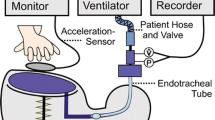Abstract
Background
The literature related to the rationale of cardiopulmonary resuscitation (CPR) including chest compressions combined with ventilations or compression-only CPR without ventilations is reviewed.
Results
The conclusion is that the evidence in favor of compression-only CPR is of limited level of evidence and does not convincingly support the superiority of compressions without ventilations, nor does it prove its non-inferiority. Theoretical and practical considerations favor continued education in the combined application of chest compressions and ventilations with a compression:ventilation ratio of 30:2.
Conclusion
Compression-only CPR should be recommended only if the rescuer is not willing or able to deliver mouth-to-mouth ventilation or when CPR is instructed by the dispatcher to untrained rescuers by telephone. For all other circumstances, trained rescuers should combine chest compressions with ventilations.
Zusammenfassung
Hintergrund
In dieser Übersicht wird die Literatur ausgewertet, die der Diskussion um die Frage zugrunde liegt, ob die kardiopulmonale Wiederbelebung unter Einsatz von Herzdruckmassage einschließlich Ventilation bzw. mit alleiniger Herzdruckmassage durchgeführt werden sollte.
Ergebnis
Im Ergebnis ist festzustellen, dass die Daten zugunsten der alleinigen Thoraxkompression von begrenzter Aussagefähigkeit sind. Sie belegen weder ausreichend die Überlegenheit der Herzdruckmassage ohne Beatmung, noch schließen sie ihre mögliche Unterlegenheit aus. Theoretische und praktische Überlegungen führen dagegen zur Bevorzugung der kombinierten Anwendung von Thoraxkompressionen und Ventilationen mit einem Kompressions-Ventilations-Verhältnis von 30:2.
Schlussfolgerung
Die alleinige Kompression sollte nur empfohlen werden, wenn der Helfer die Mund-zu-Mund-Beatmung nicht beherrscht oder ablehnt oder im Fall der Telefonanleitung eines untrainierten Helfers bei der Reanimation durch Leitstellenmitarbeiter. In allen anderen Fällen sollten ausgebildete Helfer die Herzdruckmassage mit Beatmungen kombinieren.
Similar content being viewed by others
References
Guidelines for cardiopulmonary resuscitation (CPR) and emergency cardiac care (ECC) (1992) JAMA 286:2135–2302
Handley AJ, Monsieurs KG, Bossaert LL (2001) European Resuscitation Council Guidelines 2000 for Adult Basic Life Support. A statement from the Basic Life Support and Automated External Defibrillation Working Group and approved by the Executive Committee of the European Resuscitation Council. Resuscitation 48:199–205
American Heart Association (2005) 2005 American Heart Association guidelines for cardiopulmonary resuscitation and emergency cardiovascular care. Circulation 112(24 Suppl IV):1–203
Handley AJ, Koster R, Monsieurs K et al (2005) European Resuscitation Council guidelines for resuscitation 2005. Section 2. Adult basic life support and use of automated external defibrillators. Resuscitation 67(Suppl 1):S7–S23
Sayre MR, Berg RA, Cave DM et al (2008) Hands-only (compression-only) cardiopulmonary resuscitation: a call to action for bystander response to adults who experience out-of-hospital sudden cardiac arrest. A science advisory for the public from the American Heart Association Emergency Cardiovascular Care Committee. Circulation 117:2162–2167
Babbs CF, Kern KB (2002) Optimum compression to ventilation ratios in CPR under realistic, practical conditions: a physiological and mathematical analysis. Resuscitation 54:147–157
Turner I, Turner S, Armstrong V (2002) Does the compression to ventilation ratio affect the quality of CPR: a simulation study. Resuscitation 52:55–62
Berg RA, Hilwig RW, Kern KB et al (1999) Simulated mouth-to-mouth ventilation and chest compressions (bystander cardiopulmonary resuscitation) improves outcome in a swine model of prehospital pediatric asphyxial cardiac arrest. Crit Care Med 27:1893–1899
Meursing BT, Zimmerman AN, Heyst AN van (1983) Experimental evidence in favor of a reversed sequence in cardiopulmonary resuscitation. JACC 1:610 (abstract)
Dorph E, Wik L, Strømme TA et al (2004) Oxygen delivery and return of spontaneous circulation with ventilation:compression ratio 2:30 versus chest compressions only CPR in pigs. Resuscitation 60:309–318
Nagao K, for the SOS-KANTO study group (2007) Cardiopulmonary resuscitation by bystanders with chest compression only (SOS-KANTO): an observational study. Lancet 369:920–926
Bobrow BJ, Spaite DW, Berg RA et al (2010) Chest compression-only CPR by lay rescuers. JAMA 304:1447–1454
Iwami T, Kawamura T, Hiraide A et al (2007) Effectiveness of bystander-initiated cardiac-only resuscitation for patients with out-of-hospital cardiac arrest. Circulation 116:2900–2907
Bohm K, Rosenqvist M, Herlitz J et al (2007) Survival is similar after standard treatment and chest compression only in out-of-hospital bystander cardiopulmonary resuscitation. Circulation 116:2908–2912
Olasveengen TM, Wik L, Steen PA (2008) Standard basic life support vs. continuous chest compressions only in out-of-hospital cardiac arrest. Acta Anaesthesiol Scand 52:914–919
Kitamura T, Iwami T, Kawamura T et al (2010) Bystander-initiated rescue breathing for out-of-hospital cardiac arrests of noncardiac origin. Circulation 122:293–299
Kitamura T, Iwami T, Kawamura T et al (2010) Conventional and chest-compression-only cardiopulmonary resuscitation by bystanders for children who have out-of-hospital cardiac arrests: a prospective, nationwide, population-based cohort study. Lancet 375:1347–1354
Lindner TW, Søreide E, Nilsen OB et al (2011) Good outcome in every fourth resuscitation attempt is achievable—an Utstein template report from the Stavanger region. Resuscitation 82:1508–1513
Berdowski J, Blom MT, Bardai A et al (2011) Impact of onsite or dispatched automated external defibrillator use on survival after out-of-hospital cardiac arrest. Circulation 124:2225–2232
Conflict of interest
The corresponding author states that there are no conflicts of interest.
Author information
Authors and Affiliations
Corresponding author
Rights and permissions
About this article
Cite this article
Koster, R. Chest compression-only CPR. Notfall Rettungsmed 15, 482–485 (2012). https://doi.org/10.1007/s10049-011-1566-1
Published:
Issue Date:
DOI: https://doi.org/10.1007/s10049-011-1566-1




